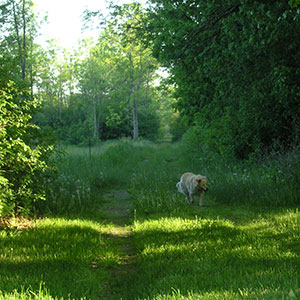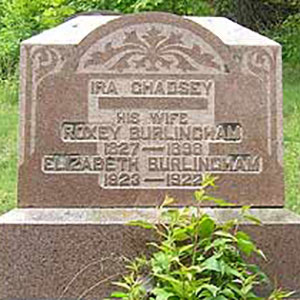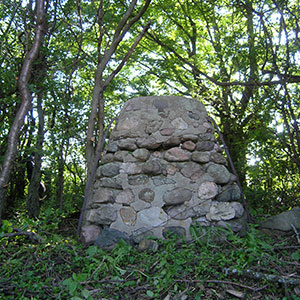Ira Chadsey and the cairns
The winery is named after an early settler, Ira Chadsey, who built stone cairns at the back of the property claiming they would guide him home in the afterlife when he returned as a white horse. A century later, the story is still being told, hence the winery By Chadsey’s Cairns.
There’s more.
A trail of orange peels
On a summer’s day in 1905, 77-year-old Ira walked down the beautiful tree-lined laneway to his maple sugar shack, leaving a trail of orange peels as he ate his last meal. His wife Roxey had been dead for seven years; the couple had been childless. As the story goes, he built a large fire in the shack and shot himself so that his body was flung into the flames. Nothing was left but the metal barrel of his gun.
By local accounts, Ira had been a nice man and a successful farmer. The one black and white photo we have of Ira shows a man with a large bushy beard and wavy white hair dressed in a three-piece woolen suit. If you peer closely, you can see laugh lines around his eyes. A few years ago customers would laugh at his crazy large beard, but now he looks like a hipster.
The reason for Ira’s suicide is unknown. Was he despairingly bereft or perhaps seriously ill? In any case, his death bears the signs of a pragmatic, self-reliant farmer who finished what he started.
Roxey under the oak tree
We also like to think Ira had a romantic side. It is said that Ira buried his wife under a magnificent oak tree that grows on a ridge near the back of the farm. It was actually four trees growing closely together so that one could sit on a seat that had formed in the middle and gaze out on the fields, the meandering Hubbs Creek and the site of the original homestead.
However, Roxey’s family moved her remains to hallowed ground in the enchanting Glenwood Cemetery in Picton where she lies under pink granite, Ira’s name chiselled above hers, the space for his birth and death dates left blank.
The cairns
As for origin of the cairns, that, too, is puzzling. Ira listed himself as an agnostic in the 1871 census, so it’s unlikely he believed in reincarnation. More probable is that after years of hauling large stones off the fields, the annual springtime crop heaved up by frost, Ira decided to do something practical and creative than merely dumping the stones in the fence line.
The cairns are six-foot high mounds of field stone carefully mortared together with metal brackets anchored on the sides for attaching wire. The 14 cairns that remain are spaced 20 rods apart around a field that was probably the horse paddock. Some cairns are still intact, shadowy grand forms in the overgrown fence line, while others are crumbling, soon to be stone pile remnants. Rusty and tottering metal fence posts, graced with lovely finial tops and trailing bits of fence wire, are interspersed between the cairns.
Clearly the cairns are part of an elaborate fence. The white horse tale may simply be a wonderful embellishment, the kind that fixes story into legend.




